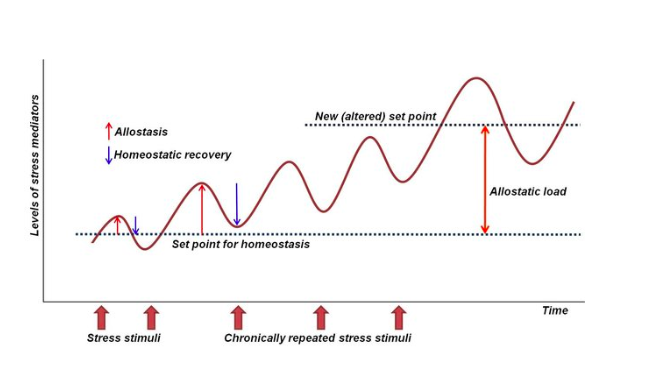I explain a breathing technique called exhale-pause breathing that serves to physiologically dampen your mind and body’s stress response while enhancing focus and relaxation.
Have you ever been sitting in your office, home, or car and for seemingly no reason you can feel your heartbeat thumping quickly, beads of sweat forming on your brow, and you just can’t focus to save your life? You’re not alone, these are symptoms of an affliction that affects millions of people, particularly in hectic go go go societies, every single day: chronic stress.
To understand what chronic stress is and why it can be so harmful, lets quickly review the science behind it. Typically, your sympathetic nervous system (SNS), commonly referred to as the “fight or flight” response, is a physiological system intended to mobilize our mind and body’s resources when faced with a high stress, survival situation.
“Do I fight this sabretooth tiger that is attacking my tribe’s village or do I flee?”
To balance that out, there’s your parasympathetic nervous system (PSNS) or relaxation response. The PSNS is commonly known as the “rest & digest” response that aides with things like recovery, calmness, and feeling centered – to name a few.
However, modern society – with all the constant doings and stimulus around us – lends itself to constant stress. Constant go, go, go. Constant information coming in. Constant expectations & deadlines.
This environment creates a mismatch between what our stress response was intended for – major, high stress moments like that sabretooth sauntering into the village – and how it’s currently used – throughout the day, constantly.
That mismatch between intended use and constant use is the foundation for chronic stress. The term “allostatic load” is used to describe the “cost” of chronic stress on the mind and body over time. This increased cost has been linked to a myriad of maladies including insomnia, anxiety, high blood pressure, muscle pain, increased pain sensitivity, system wide inflammation, burnout, and a weakened immune system. Further, it’s been shown to contribute to serious medical conditions such as depression, obesity, addiction, heart disease, and adversely harm our cardiovascular, neuroendocrine, central nervous, and immune systems.
The message is loud & clear: If we truly want to address our health, we have to address chronic stress. I’m sure you’ve heard this before at some point and self-admittedly, it’s much easier said than done. For that reason, my goal is to provide you with a quick, practical breathing technique that addresses multiple underlying factors.
This technique, which I refer to as “exhale-pause breathing” will help downshift you from that stressed out response to a relaxed one while, and this is key, getting you more comfortable with actually being relaxed. We’ve become so used to being in the stressed out state that our mind and body consider it the new-normal; therefore, it takes effort and some discomfort – as it does when trying to change any habit – to shift that norm back into balance.
So without further ado, find a space that is relatively devoid of distraction and do the following:
-
Lay flat on your back. If it’s more comfortable for you, bend your knees with your feet flat on the floor. I recommend closing your eyes but if you’re not comfortable with that, leave them open.
-
Put your hands on your ribcage. This is going to provide key feedback on the depth of your exhale.
-
Take a deep breath in (inhale) and now breathe out (exhale) as deeply as you can. The first few times you exhale, push down gently on your rib cage and you’ll likely feel more air come out. We don’t like to exhale and I’ll explain why shortly.
-
Repeat this deep inhale and exhale twice. Repeat it for a third time but do not breathe back in after the third exhale. Use your hands on the ribcage as feedback for whether you’ve actually exhaled all of the air out from your system. Now hold that position without any air in your system. Hold it for as long as you can until you start to feel a distinct “air hunger” and then breathe back in.
Here’s a video of me doing it (practice what you preach!):
Here’s what this technique is accomplishing from a physiological basis:
Whenever we inhale, our sympathetic nervous system is activated. That’s reflected by the fact that our heart rates goes up with every inhale. Whenever we exhale, our parasympathetic nervous system kicks on. Our heart rate goes down. It’s a pendulum that swings back and forth.
This concept is the foundation for using heart rate variability as a measure of stress.
In my experience, most people are great at inhaling and holding their breath but aren’t so good at exhaling and being without air in their system. Intuitively, this makes sense. If you’re always stressed out and used to being stressed out, you’re now biased towards the exhale because of its relationship with the sympathetic nervous system. That pendulum is only swinging one way.
What this breathing technique does is take that pendulum, swing it back to relaxation, and hold it there, while giving you external feedback cues (the hands on the ribs) to make sure you’re not cheating!
As you get comfortable with the technique, you can even start to count how many seconds you’re able to stay in that deeply exhaled position. With consistency – I suggest doing this during lunch and in the early evening, I also do it after workouts as an “off-switch” – you will see that count increase as you become more and more comfortable in that exhaled, parasympathetic state. Your system is acclimating and becoming comfortable with actually being relaxed. You can’t truly relax if you aren’t comfortable with relaxing in the first place.
Give it a try and I hope it provides you with an anchor point throughout the day to help reduce your stress level and balance the swing of that stress-relaxation, SNS-PSNS pendulum.
Thanks for reading and until next time.





What would you say is a good amount of time to do this breathing exercise? 5 mins – 10 mins?
If you want to do it for time, I typically would suggest 3-5 mins. Personally, I do it for upwards of 10 repetitions (not sure how long total that is).